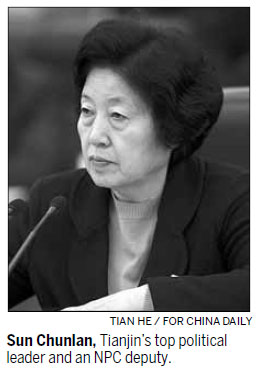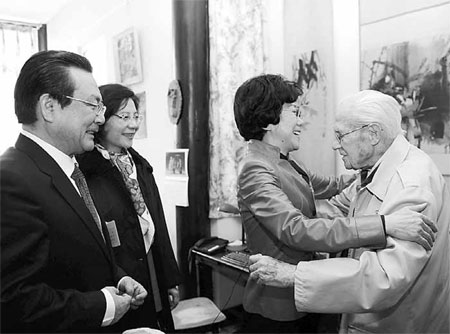Joint development touted as win-win-win
Updated: 2013-03-10 08:01
By Zhao Yinan and Jin Zhu(China Daily)
|
|||||||||
|
Man of many words CPPCC members visit famous translator Sidney Shapiro on Saturday at his home in Beijing. The 98-year-old US-born wordsmith devotes himself to translating Chinese literature. He is a CPPCC member absent from the ongoing session due to poor health. Photo by Jin Liangkuai / Xinhua |

Tianjin and Hebei eager to coordinate plan with capital
Deputies from Tianjin and Hebei province, Beijing's nearest neighbors, are mulling a regional plan with the capital to promote coordinated development.
Experts said the draft plan would boost the economy in Tianjin and Hebei while taking pressure off Beijing, but it can be difficult to coordinate individual interests among the three and reach a blueprint.
Sun Chunlan, Tianjin's top political leader and deputy to the National People's Congress, said on Saturday that Tianjin's proximity to Beijing is a geographical advantage, which it should exploit to the most.
Tianjin, located southeast of Beijing, has Wuqing district and Jixian county in the north, bordering the capital. The two cities are also connected with Beijing by two highways and a high-speed rail that cuts travel time to 30 minutes.
Authorities from Hebei province also believe that as a close neighbor, the development of the "capital economic circle" is very important to Hebei's future development.
"The development of such an economic circle will help Beijing to relieve current pressures on population, transportation, and environment," said Zhao Yong, deputy Party chief of Hebei province and an NPC deputy. Some industries in Beijing have already shifted their manufacturing bases to Hebei, he said.
Yang Chongyong, a vice-governor of Hebei and an NPC deputy, called for more support for his province during the development of the economic circle.
At present, six cities, including Langfang, Baoding, and Chengde, have been listed in the plan. "We hope more cities, such as Shijiazhuang, Hengshui, and Cangzhou can also be listed," he said.
"Hebei is small compared with Beijing and Tianjin in the capital economic circle. More rapid development of strategic emerging industries and technological innovation are urgently needed in the province," Yang said.
Meanwhile, Hebei is expected to boost its public service and tackle poverty in future with the development of such an economic circle.
Zhang Zhiqiang, head of Tianjin Municipal Commission of Development and Reform and a deputy to the NPC, made a similar proposal urging the State Council to approve a draft blueprint on the regional cooperation and development in Beijing, Tianjin and Hebei province.
Zhang said the regional draft, the first of its kind in the country when it was proposed in 2006, has yet to be approved by the State Council.
The development plan for the Yangtze River Delta, an area that covers Shanghai's Pudong and its surrounding communities, is already in effect, although it was initiated later.
"One of the intentions of the capital draft is to promote mutual development as Beijing develops."
For instance, since most of the universities and think tanks are based in Beijing, the city will be overburdened if academic research produces more industrialization in the capital. However, Tianjin and Hebei could be ideal locations for such industry transfers, he said.
There are potential conflicts, such as the choice of infrastructure support. For instance, Hebei and Tianjin are both on the coast while Beijing is an inland metropolis.
"Which port would Beijing prefer to use in future?" he asked.
Zhang said such problems couldn't be solved through local government but through an overall plan that must come from the central government which will allocate the best distribution of regional resources.
Contact the writers at zhaoyinan@chinadaily.com.cn and jinzhu@chinadaily.com.cn.
Zhang Min in Tianjin and Pei Pei in Hebei contributed to this story.
(China Daily 03/10/2013 page2)
